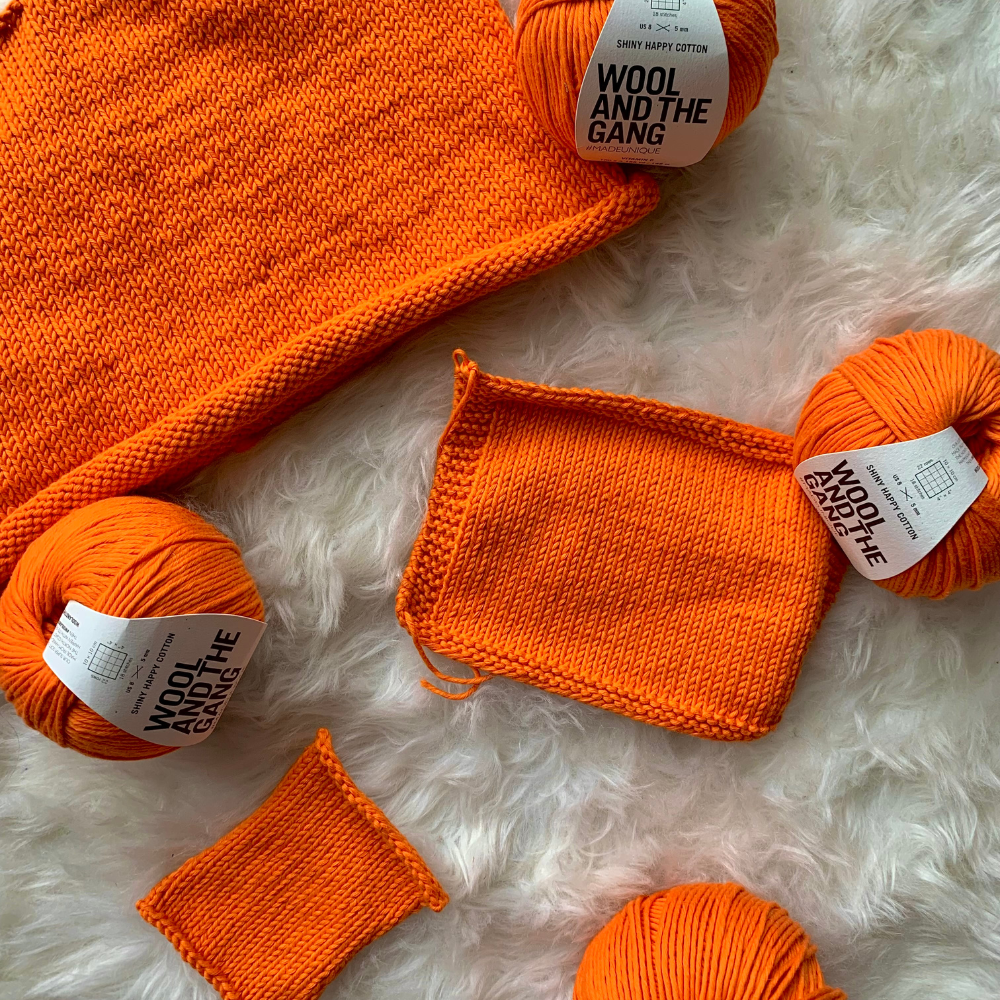Knitting with Cotton Yarn: Your Complete Guide
With spring heating up and summer fast approaching, you’re probably itching to cast on your warm-weather knits (if you haven’t gotten a head start already). A popular fiber to use to keep cool on hot days is cotton. However, cotton behaves very differently than wool or synthetic fibers. To make sure your spring and summer finished objects are as cute as can be, keep reading to learn the types of cotton, how cotton behaves, tips and tricks when working with cotton yarn, and what the best and worst projects are for cotton yarn!
(Please note that this post contains affiliate links. If you make a purchase after clicking an affiliate link, I earn some yarn money at no extra cost to you!)
Types of Cotton Yarn
It’s important to know the different kinds of cotton fibers you can find on the shelf at your local yarn shop. There is:
Egyptian & Sea Island Cotton Yarn
Egyptian and Sea Island cotton yarns are considered to be the finest cotton fibers. These kinds of cotton are very soft and are resistant to fraying and pilling. Drops' Safran yarn is a great Egyptian Cotton option.
Pima Cotton Yarn
Pima cotton yarn is extremely similar to Egyptian cotton but is primarily grown in the United States. (Fun Fact: The name “Pima” comes from the Pima American Indians of Arizona as they helped USDA scientists experiment with breeding Egyptian cotton in the early 1900s.) Cascade Yarn has some gorgeous Pima Cotton if you're interested!
Organic Cotton Yarn
Organic cotton fibers are grown without pesticides or synthetic fertilizers. This is a good option if you’re looking to be more sustainable and support farming that produces less pollution. Gazzal has some really nice Organic Baby Cotton that is pretty affordable!
Recycled Cotton Yarn
Recycled cotton yarn is made from recycled fabric. This is a great sustainable option! Cotton takes a lot of water to produce. However, recycled cotton yarn uses less water and gives life to fabric that might otherwise be in a landfill. Stitch & Story’s Eco Cotton Yarn is made from 95% recycled cotton!
Mercerized Cotton Yarn
Mercerized cotton isn’t a type of fiber, but a treatment that is done to the cotton fibers. The treatment involves submerging cotton in a soda solution that results in a more strong fiber that is more receptive to dye. The end result is a yarn that is almost silk-like and has vibrant colors. Also, because mercerization causes the fibers to be condensed even closer to one another, the fabric you make with it will actually be even cooler and airier compared to non-mercerized cotton. 24/7 Cotton by Lion Brand is a popular and affordable cotton yarn, and it is mercerized!
Learn about the most and least sustainable yarns here!
How Cotton Yarn Behaves
Regardless of which type of cotton yarn you buy, cotton as a whole is a very strong fiber. It has more durability compared to wool. Also, cotton yarn doesn’t make you sweaty or itchy in the summer like wool might. Instead, cotton’s superpower is being able to absorb water and quickly evaporate it, leaving the wearer cool and comfortable in warm weather.
Tips and Tricks for Cotton Yarn
Now that we got some of the basics down, here are some important cotton quirks to keep in mind when you’re starting and working on a cotton yarn project.
1. Cotton stretches
You know when you put on a top that is very form-fitting and it stretches to hug your curves? And when you take it off, it snaps back to looking like normal? That means that the top has memory or elasticity. However, cotton fiber lacks memory, so your cotton FO tends to take the form of however it is pulled and stretched when it is worn.
A short-term fix for an FO that has been stretched after it has been worn is to block the garment. Blocking helps to reset the fibers and settle the stitches back into their original positions. However, over time, blocking won’t be able to reset the stitches and the garment will inevitably become more relaxed.
2. Cotton makes a more loose-fitting fabric
Because of cotton’s lack of memory, it’s best to choose loose-fitting garments or garments that drape for cotton instead of tight, form-fitting garments. Even ribbing alone won’t be able to get the garment to cling to your body. (Make sure to keep reading to see what kind of projects I recommend for making with cotton!)
If you really want to make a tighter-fitting garment with cotton, try using a blended cotton yarn! When cotton is blended with wool or nylon, it will have a bit more elasticity. For example, Comfy Worsted, Comfy Fingering, and Comfy Color Mist from Knit Picks are great options as they are 75% Pima cotton and 25% acrylic microfiber and come in SO many great colorways!
3. Cotton yarn could have a bias
Cotton can be tricky to spin. The fiber itself has a natural twist, and then the fibers have to be twisted more in the spinning process. If all of those twists aren’t correctly accounted for, it could result in the fabric having a bias or a tilt. This is one reason why it is super important to block your cotton gauge swatches. But if you block a cotton gauge swatch and notice it looks more like ▱ than 🔲 , then the yarn you’re working with has a bias.
However, not all hope is lost if you discover your cotton yarn has a bias. If you were to use that yarn in a pattern that calls for a lot of stockinette, then your project will likely look a bit italicized. But you can use that biased yarn with a pattern that uses a mixture of knit and purl stitches, like seed stitch, to balance out the twist.
4. Cotton is heavy
Compared to other fibers, like wool or acrylic, cotton tends to make a heavier fabric. This heavier weight is important to keep in mind when considering doing a project with elements like cables or bobbles because the finished garment could weigh more than you’d like. If you’re set on making a super cool cabled top with cotton though, then just keep your eye out for a light-weight cotton blend.
5. Cotton is slippery!
When working with cotton yarn, you may find that it is more slippery than wool and other animal fibers. I recommend using a wooden needle, which offers a bit more grip than a metal needle. Using a metal needle with cotton is a very slippery combination and could lead to a weird, inconsistent gauge.
Also, I recently learned a very valuable lesson. I was working on a cotton project in the round, but I swatched the yarn for the project flat. My gauge ended up being two stitches off, and the garment was ginormous. I had to end up frogging. So if your cotton project is going to be worked in the round, please learn from my mistake and swatch in the round! (Many will say you should swatch in the round if your pattern is worked in the round, regardless of the fiber you are using. Those people may be right, and I plan on doing this more in the future. However, I never had issues with swatching flat and then working in the round before with other fibers. Just sayin’.)
And lastly, because cotton is more slippery than other fibers, it requires more focus from your hands, wrists, and arms. Your mind may not notice that additional focus, but your body will. If you’re working with cotton for days or weeks at a time, you might notice soreness in your hands, wrists, or arms. I was actually working with cotton when I got an RMI last year, and as I’m working with a cotton project now, I notice my arm twinging if I work too long on it. To avoid an injury, make sure to stretch regularly, take breaks, and maybe work on a non-cotton project on the side so you can bounce between the two.
Learn the best stretches for knitters here!
6. Caring for your cotton knits
Did you know that wool is naturally odor-resistant? So cool! And you may not wash your wool garments that often because of that super neat feature. However, the same does not hold true with cotton. As a result, you may need to wash your cotton knits more frequently than your wool knits, especially if you’re wearing them often in warm weather.
Cotton is also unlike wool in that many cotton yarns can be machine washed! Of course, you can still wash by hand if you prefer. Either way, it is important to lay your cotton knits flat to dry so that the fibers can set properly in the shape you want.
Because of cotton’s lack of memory, you may notice that your cotton garments hold more wrinkles when you unfold them and put them on. To get rid of wrinkles, you can iron but please be gentle. I suggest putting the iron on high steam and applying only the slightest bit of pressure from the iron itself. Or you can use a steamer!
What to make with cotton yarn
With all of these tips and tricks in mind, let’s talk about what projects would be awesome to use cotton yarn for. Cotton yarn would be great for:
Loose summer tops, like tank tops, vests, cardigans, and sweaters
A beach cover-up but not bathing suits (Check “what not to make with cotton yarn” below to learn why.)
Functional projects for the home, like market bags, wall hangings, plant hangers, pillow covers, bookmarks, book or tablet covers, pot holders, coasters, dishcloths, face and shower scrubbies, makeup remover pads, towels, and rugs. So many options! Cotton works well for these kinds of projects because of its durability and tendency to not pill when introduced to friction. Dishie is a great cotton yarn for these kinds of projects as it is quite affordable and comes in sooo many colorways.
Baby blankets and clothes because cotton is soft and easy to care for. Shine Sport and Shine Worsted from Knit Picks are great options for baby projects because of their softness and easy washability!
What not to make with cotton yarn
Here are projects you should avoid making with cotton:
Anything that requires a lot of stretch or form-fitting because of cotton’s lack of memory and loose-fitting tendencies. This category includes tops with negative ease, form-fitting bottoms, and socks.
Bikinis or bathing suits because cotton can hold a lot of water. Combine that water-holding ability with the stretchiness of knitted fabric, a wet bathing suit that is knitted with cotton yarn will have what every baker on The Great British Baking Show never wants their pie to have: a soggy bottom. However, crocheting a bathing suit with cotton would be better because crochet has tighter stitches and wouldn’t sag as much.
There you have it! If you made it this far, then you are practically a cotton yarn expert now. You know the different types of cotton, how it behaves, it's quirks, as well as what to make and what not to make. Now grab your cotton, get swatching, and cast on your summer knits! If you found this blog post helpful, be sure to share it with a knitting pal!



